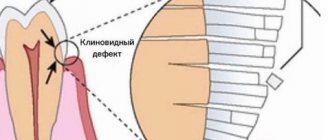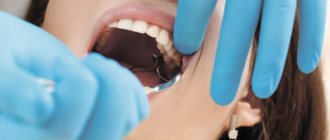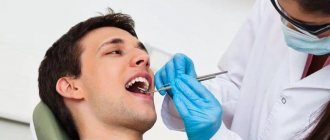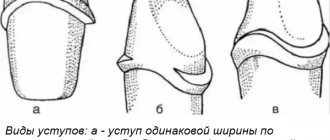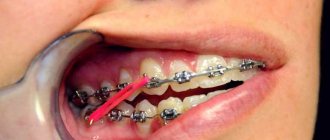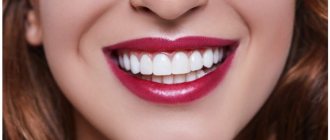When hearing the word “dentistry,” a person first of all imagines a specialist in a white coat drilling teeth using a drill.
But we must not forget that in addition to the treatment of caries and the elimination of pulpitis, there are other specializations among dentists.
When eliminating defects in the dentition and problems with the jaws, it is necessary to take x-rays, make dentures, etc.
A separate area is operations performed by a dental surgeon.
In what cases should I contact
As planned
A visit to a dental surgeon is mandatory for children from 1 to 3 years old. During this time, it is necessary to carry out from one to several examinations by a specialist in this profile. The doctor should first examine the child at 1 year of age. By this age, approximately 8 baby teeth have already grown, the rest are in the process of erupting. The doctor checks them for the presence of caries, inflammatory diseases, assesses the sensitivity of the enamel, and checks their correct location. At this time, bite pathologies can be detected in time.
Routine examinations are also indicated for patients with neoplasms in the maxillofacial area, as well as for persons who have previously undergone surgery. In this case, the doctor observes the pathology for progression or degeneration when it comes to benign tumors, fistulas, keloid scars, etc.
Unscheduled
Unscheduled assistance from a dental surgeon may be needed in many cases. It is necessary for a number of diseases and medical problems. Here is a list of the main ones:
- Removal of teeth and administration of anesthesia . A dental surgeon can remove damaged and diseased teeth, as well as administer anesthesia (infiltration and conduction).
- Placement of dental implants . A dental surgeon can help with dental implants. He works on bone reconstruction in the areas where implants will be placed. If necessary or desired by the patient, the dental surgeon can also modify the gum tissue around the implants to create a more natural and attractive appearance.
- Treatment of facial injuries . Dental surgeons can treat small and complex lacerations on the face, restore broken jaws and facial bones, and nerve endings. Their expertise includes facial injuries that involve the tissues of the mouth, jaw, cheeks, nose, eye sockets and forehead.
- Assessment of pathological conditions . Oral surgeons treat patients with benign cysts and tumors of the mouth and face, malignant neoplasms, and severe infections of the mouth, salivary glands, jaws and neck.
- Elimination of pain syndrome . A dental surgeon can diagnose and treat facial pain that is caused by temporomandibular joint (TMJ) problems.
- Reconstructive and cosmetic surgery . A dental surgeon can correct problems with the jaw, facial bone and soft tissues of the face that have arisen as a result of injury or removal of tumors. Such corrective surgeries restore the shape and function of the maxillofacial area.
- Correction of birth defects . Oral surgeons also surgically correct congenital defects of the face and skull, such as cleft lip or cleft palate.
Comments
My mother lost a tooth and more than once she visited a dental surgeon who recommended installing an implant. She does not dare to undergo this operation. He says that when installing an implant there are risks: rejection, complications. Is this true and what to do in this case?
Maria (06/15/2018 at 05:56) Reply to comment
A couple of years ago, a paid dental surgeon successfully removed the upper eight, warning me before the manipulation that a through hole could form into the nasal cavity. He said that if this happens, it will have to be stitched up in the surgery department at the general hospital. But, fortunately, everything worked out. There is another 8 in the pipeline in the future. Please tell me if there are any dental clinics where fistulas are sutured on the spot. And does the dental surgeon directly do this immediately after wisdom tooth removal?
Tatyana (06/15/2018 at 06:58) Reply to comment
The photos in the article are frankly terrifying. Does a dental surgeon work together with an anesthesiologist? I can't believe that people can endure all these surgical procedures under local anesthetic.
Olesya (06/15/2018 at 07:38) Reply to comment
And I just lost my wisdom tooth, which could not crawl out from under the gum hood on its own. I pulled and pulled until the dental surgeon removed this pocket completely with a laser - quickly and cheaply! The tooth was then treated for “white” caries. But I’m wondering: at what stage of wisdom tooth eruption should I contact a dental surgeon in order to prevent the development of caries under the mucosa? At what stage does a tooth begin to rot?
Katya (06/15/2018 at 07:47) Reply to comment
A few months ago I needed to remove the eight. I was terribly afraid, I had read a lot of cases where a tooth breaks off, fragments remain, and then rotting and infection begin. But I was lucky with the surgeon - he removed the tooth in 5 minutes and without complications at all.
Christina (06/18/2018 at 09:55) Reply to comment
A dental surgeon must also be a psychologist and be able to properly “tune” the patient so that he is not afraid. I wonder if in medical schools they teach dentists psychology or some techniques for communicating with patients?
Marina (06/18/2018 at 10:18 am) Reply to comment
There are many times when you need the help of a dental surgeon, most often during tooth extraction, of course. But for more serious operations, do they administer anesthesia themselves or is there a separate doctor for this?
Anita (06/18/2018 at 10:33 am) Reply to comment
After the tooth was removed, a piece of the root remained in the gum. I can really feel it on my tongue! The gums are swollen and swollen. The dentist who removed the tooth said that I needed to see a surgeon to cut the gum. What anesthesia will be used in my case? Another problem, I'm breastfeeding. Is it possible to use anesthesia for this?
Alina (06/18/2018 at 10:35) Reply to comment
If the wisdom tooth is positioned correctly, has grown normally and does not cause any trouble, then does it need to be removed? I just know that now most people remove wisdom teeth without any indication, considering them harmful in advance.
Inna (06.27.2018 at 14:12) Reply to comment
I was really upset: if in the clinic where I had my tooth removed (I had a cyst), I had been seen by a dental surgeon from the very beginning, then maybe through partial removal, as in the second example, the tooth would have been saved... I read about implantation and thought: Is it worth asking for a consultation with a dental surgeon before installing not an implant, but crowns - a fixed bridge? Or is this the prerogative of the orthodontist?
Irina (06/27/2018 at 15:39) Reply to comment
I am glad that dental surgeons are trained well, but for some reason I am terribly afraid of them. I went in as an adult only once to have a figure eight removed; on the whole it was not painful, but scary. Has anyone had figure eights removed under general anesthesia? I just read on the Internet that there is such a practice.
Nina (06/27/2018 at 16:16) Reply to comment
Write your comment Cancel reply
What diseases does it treat?
Among the main diseases treated by a dental surgeon:
- periodontitis;
- diseases of the TMJ (temporomandibular joint);
- periostitis;
- osteomyelitis;
- tumors and cysts of the oral cavity;
- diseases of the salivary glands;
- sinusitis;
- abscesses;
- trigeminal nerve diseases;
- phlegmon and others.
A doctor of this profile also diagnoses some specific systemic diseases that manifest themselves in the oral cavity. Among them: syphilis, actinomycosis, scurvy, tuberculosis, etc. For such diseases, treatment is prescribed to the patient by another doctor (infectious disease specialist, virologist, pulmonologist).
Responsibilities of the surgeon
To perform operations, it is not enough to obtain a higher education in the specialty “Dentistry”. Additionally, you should undergo retraining or residency in the specialty “Surgical Dentistry”. But theoretical knowledge is not always enough. The best dental surgeon must be able to reassure the patient and set him up morally for a positive outcome of the surgical intervention. Long-term practice and a large number of positive reviews indicate high qualifications.
The job description of a dental surgeon is the main document that should guide a specialist when performing his duties. A qualified dental surgeon must:
- comply with safety precautions and labor protection rules;
- adhere to internal rules;
- timely carry out orders from the management of the medical institution;
- manage lower-level medical personnel;
- provide qualified medical care for identified diseases using modern methods of surgical treatment and diagnosis;
- draw up a patient treatment plan;
- adjust the treatment plan if necessary;
- carry out examinations of patients after surgery in the hospital.
The responsibilities of a dental surgeon are quite varied. Such a specialist not only performs surgical treatment of advanced diseases, but also monitors the work of nurses, monitors the patient’s condition, and maintains working documentation.
Preparing for your appointment
Before going to the dentist, you need to have a hearty snack - after surgical procedures, you should not eat food for several hours. On the eve of the visit, drinking alcohol is contraindicated - it can negatively affect the effect of anesthetics (painkillers will not work). Immediately before visiting a doctor, you need to perform thorough oral hygiene.
Patients who have encountered acute infectious diseases of the ENT organs, rashes in the oral cavity, or herpes on the lips should avoid visiting a specialist. Women are not recommended to undergo surgical procedures on menstruation days, since at this time the body is in a weakened state.
You must bring your medical history, reports from previous examinations, and all x-rays (if available) with you to your appointment.
Dentist-orthodontist
People most often consult an orthodontist for aesthetic purposes. An orthodontist corrects teeth misalignments and corrects malocclusions. It is thanks to orthodontists that you can make your smile attractive and your teeth perfectly straight. To correct the bite and incorrect position of the teeth, various braces are used, both removable and permanently worn.
This article is posted for educational purposes only and does not constitute scientific material or professional medical advice.
How is the appointment going?
Like any other specialist, a dental surgeon first of all listens to patients’ complaints and collects anamnesis. He must know everything related to the problem that worries the patient. Then it’s time for a visual inspection. The doctor examines the problem area, and he can use tools such as a dental mirror, spatula, probe and others.
Using light tapping, the doctor identifies the area that is causing pain. If we are talking about soft tissues, palpation is performed. The doctor pays attention to swelling, redness, altered areas of the skin and mucous membranes, as well as the patient’s appearance. How the examination will be carried out directly depends on the specific case.
Manipulations performed
The dental surgeon performs the following treatment measures:
- tooth extraction and implant installation;
- removal of cysts and opening of abscesses;
- correction of the consequences of maxillofacial injuries, removal of foreign bodies from the oral cavity;
- restoration of jaw proportions;
- bone grafting and flap operations;
- gum plastic surgery and curettage;
- cosmetic surgeries – gingivitis, vestibuloplasty and frenuloplasty;
- elimination of gum recession;
- treatment of inflammatory diseases of the oral cavity - periodontitis, purulent periostitis, pericoronitis, alveolitis and others.
Implantation
One of the most common methods for restoring an entire tooth. Implantation is carried out by implanting a titanium root into the jawbone, in place of the extracted tooth . If the clinic does not have a doctor with a specialization as an implantologist, the implantation is carried out by a surgeon.
In addition to the implant installation procedure, the surgeon may be required to perform additional manipulations aimed at restoring bone tissue in the area of implantation. Most often, it is necessary to first carry out a sinus lift - bone augmentation in the upper jaw in the area of the maxillary sinuses.
This is interesting: What is incomplete tooth luxation and why does it happen - symptoms and treatment methods
Also, a dental surgeon can work to remove the old implant or put an artificial crown on it.
Some of the nuances of this procedure are described in the following video:
Removal of a tooth
The priority of dentists is tooth-preserving treatment, but if it is impossible to save a tooth, surgeons resort to its removal - extirpation.
Removal is usually performed under local anesthesia. In exceptional cases, general anesthesia may be used if indicated. There are simple and complex tooth extractions.
Simple extirpation is carried out for single-rooted or mobile teeth that are not complicated by inflammatory or other pathological processes. The operation is performed with one instrument - forceps.
Removal is considered difficult if the use of additional medical supplies and special instruments is required. This happens with dystopic and impacted teeth, hypercementosis, root fractures, fusion of teeth with the jaw bone, complications of periodontitis, extirpation of third molars.
Stages of a simple tooth extraction
- Anesthesia.
- Destruction of the periodontal junction (syndesmotomy).
- Application, advancement and fixation of forceps.
- Destruction of the connection between the tooth and the periodontium - luxation (rocking) or rotation (rotation).
- Extracting a tooth from the alveolus (traction).
The technique for removing complex teeth depends on the clinical situation. In this case, several tools are necessarily used:
- An elevator (for dislocating a tooth) and an excavator (for extracting the root from the depths of the hole).
- Bit. It is usually used when a tooth is broken in the depths. Please tell me that the alveoli, when the root cannot be reached with an excavator or elevator. Using a chisel, the alveolar wall is removed so that the root fragment can be captured with the instrument.
- A drill used to cut a tooth into pieces and remove the bone surrounding the tooth.
Cystectomy
This procedure is a partial removal of the root of a tooth on multi-rooted teeth, and is used when a cyst is detected . Cystectomy allows you to remove a small cyst while preserving the main root part of the tooth.
The procedure begins with anesthesia, after which the doctor creates access to the tooth through the gum and periodontal tissue. In the opened bed, the dentist enucleates the cyst and removes it along with the tip of the affected root.
The root canal is cleaned and filled with a special material that promotes bone tissue restoration. Despite the fact that cystectomy is a radical technique, it allows you to save the tooth and the neurovascular bundle that feeds it.
Sequence of cystectomy with tooth root resection
- From the vestibular surface of the alveolus in the projection of the cyst, a piece of the mucous membrane of the gums of a trapezoidal or semi-oval shape is cut out and peeled off.
- Using a cutter, a window is cut into the bone to provide access to the cyst.
- The tip of the tooth root is cut off.
- The contents of the cyst are removed (scraped out).
- The surgical wound is filled with bone substitute and sutured.
- Antibacterial therapy is prescribed.
Gumplasty
One of the common dental defects is incorrect placement of the gum contour. It can be congenital or acquired, due to periodontal inflammation. Such a defect leads to gum recession, gum disease, and the development of caries.
Gum grafting can help correct this problem . The surgeon, with simple manipulations, will increase the contour of the gums, lower them, or evenly distribute them over the entire periodontal part of the visible area.
This technique is especially actively used in cases of severe periodontal disease, when periodontal tissues are not able to recover on their own.
Gum grafting can be performed during flap surgery or as a stand-alone procedure with delayed surgery. If there is excessive formation of periodontal tissue, it is excised.
Insufficient volume or high position is compensated by dissection of the gums of the problem area or transplantation of a mucosal flap from another part of the oral cavity.
Flap operations
Patch-type operations are one of the most effective methods for restoring gums in case of periodontitis, thinning gums, and destruction of the jaw bone. The procedure eliminates enlarged gum pockets and overgrown periodontal tissue .
The operation involves removing tissue until the bone of the alveolar ridge is exposed. After this, the pathological epithelium and granulation are removed and the roots of the teeth are polished. If necessary, material is implanted to restore the bone.
A gum is formed from the remaining flap and fixed with sutures. A periodontal bandage is applied to the operated area. Despite the traumatic nature of the operation, healing occurs after 7–10 days.
Curettage
Many diseases of the oral cavity develop due to plaque formation in the areas of contact between the gums and the surface of the teeth.
For treatment and prevention, surgical intervention is performed to eliminate the cause of possible inflammation. The operation is performed using a curette .
With their help, you can penetrate five millimeters into the intergingival space, and you can administer medications to treat infections. If necessary, dressing is performed.
Curettage technique
After antiseptic treatment of the RP and local anesthesia, subgingival and supragingival deposits and granulations are removed using a scaler and curette. The surgical site is treated with antiseptics, and antiseptic ointments are applied if necessary.
The entire operation takes about half an hour. Due to anesthesia, the patient does not experience any discomfort.
Open curettage is indicated when the depth of periodontal pockets is more than 5 mm , the growth of granulations, detachment of the gingival margin from the tooth, and deformation of the papillae. The difference between open and closed curettage is the detachment of the gum from the tooth during cleaning. This provides visual control of the operation and allows for the most effective removal of destroyed tissue and deposits.
Restoration of jaw proportions
The word "gnathia" (Greek gnathos - jaw) means "pertaining to the jaw." Malformations of the jaws, expressed in increased (macrognathia) or decreased (micrognathia) sizes, as well as retraction (retrognathia) or protrusion (prognathia) of the jaws relative to each other, are treated with the help of orthodontic appliances or surgery.
This is interesting: Perforation of the maxillary sinus during tooth extraction: features and methods of determination
Plane osteotomy, a surgical method for correcting retrognathia and prognathia, is the most common and effective method for correcting violations of jaw proportions.
In the lower jaw, it is possible to perform a planar osteotomy using an intraoral approach, which avoids facial scars.
Operation technique
- The mucous membrane and periosteum of the jaw is cut in the projection of the pterygomaxillary fold. The edges of the incision are moved apart to provide access to the bone.
- Compact plates of the lower jaw are sawed with a surgical saw on both sides, the separated fragments are moved to the desired position and fixed with collagen or titanium plates with bolts or suture material.
- Lipofilling is performed - filling the free space between the bones with the patient's fat cells taken from another area.
The operation is performed under general anesthesia and usually lasts from one and a half to two hours.
Bone grafting
Insufficiency of bone tissue in the area of implantation often requires the intervention of a dental surgeon, who restores the required volume using special materials.
They can be a synthetic bone-forming substance, material obtained from animal bone, or a small fragment of the patient’s own bone. The grafting procedure involves detachment of the mucous membrane and perforation of the bone, into which a restorative substance or fragment is injected.
Diagnostic methods
In surgical dentistry, instrumental and laboratory diagnostic methods are used. These include:
- taking anamnesis;
- visual and manual inspection;
- temperature diagnostics;
- X-ray examination (x-ray and orthopantomogram);
- electroodontic diagnostics;
- general blood test, etc.
If oncological processes are suspected, the patient is prescribed a biopsy and a series of cytological studies. With their help, you can determine the type of neoplasm, as well as confirm or refute its benignity.
If there are concomitant diseases that are not within the competence of the dental surgeon, the patient may need the help of other specialists. In particular:
- orthodontist;
- orthopedist;
- gastroenterologist;
- oncologist;
- infectious disease specialist;
- allergist, etc.
Interaction with other specialties
© Robert Kneschke/Fotolia
The specialty of a dental surgeon involves close interaction with doctors from all areas of dentistry. The surgeon can remove teeth only after the therapist confirms the impossibility of saving them .
Extraction cannot be carried out without the testimony of an orthodontist, who monitors the correct development of the bite and dentition. The work of an orthopedist also cannot do without the participation of a surgeon, since in order to install dentures, it is necessary to remove all roots and bad teeth.
If you find an error, please select a piece of text and press Ctrl+Enter.
Tags: implantation, tooth removal
Did you like the article? stay tuned
Previous article
Orthopedic dentist: what does this specialist do and what does he treat?
Next article
Dental prosthetics without turning: types, advantages, prices
Treatment methods
Surgical dentistry provides a wide range of treatments, which include special methods of surgical influence on the tissues of the oral cavity. The specific choice of treatment method depends on the disease. This section of dentistry practices the following treatment methods:
- bone grafting;
- tooth extraction operations;
- aesthetic surgical operations;
- implantation;
- prosthetics;
- resection of soft tissues.
After surgery, anti-inflammatory, antihistamine, antiprotozoal and antibacterial drugs may be prescribed. If pain is present, anesthetics are indicated.
Cosmetic surgeries
© Francesco83 / Fotolia
In addition to operations performed for therapeutic purposes, the surgeon performs interventions for cosmetic restoration of the maxillofacial apparatus.
Gingivoplasty
This technique is aimed at eliminating defects in periodontal tissue associated with its uneven position. Gingivoplasty is necessary for high, uneven or low gum lines.
For correction, periodontal tissue from the problem area is used, separated into flaps, or a flap is transferred from the palate. The periodontal tissue is given the required shape using surgical sutures, which are removed after 10 days.
Vestibuloplasty
It is a technique designed to expand the vestibule of the oral cavity by moving facial muscles deeper into it. The procedure is carried out by cutting the mucous tissue that regulates the tension of the gums.
After weakening the muscles of the vestibule, the likelihood of developing periodontal diseases decreases, and speech therapy problems are eliminated.
The vestibuloplasty procedure is presented in the following video:
We will tell you what to do if your gums hurt for a long time after tooth extraction.
We talk here about complications after removal and treatment.
We will discuss the resection of the apex of the tooth root at the link https://www.vash-dentist.ru/hirurgiya/rezektsiya/verhushki-kornya-zuba-zachem-nuzhna-operatsiya-i-kak-ona-provoditsya.html.
Frenuloplasty
The main indication for frenuloplasty is shortening of the frenulum of the tongue or lips , exposing the neck of the teeth, or the formation of a speech therapy defect. The incision is made under local anesthesia, using a scalpel to excise the frenulum in the transverse direction.
Elimination of gum recession
When the volume of the gums decreases (recession), accompanied by exposure of the roots of the teeth, flap surgery is resorted to. A section of mucous membrane taken from the palate or another area of the oral cavity is applied to the gum, after which the tissue is secured with sutures.
After a week, the mucous membrane takes root and the sutures are removed.


